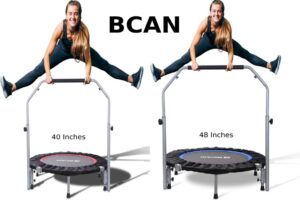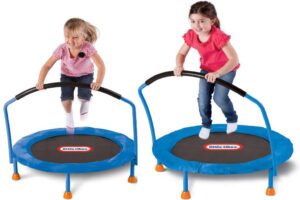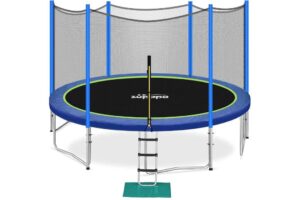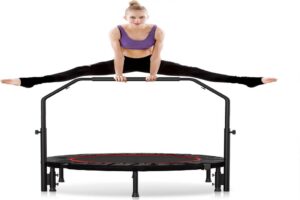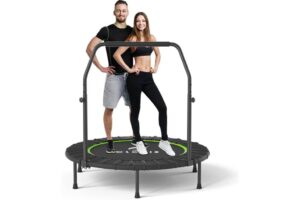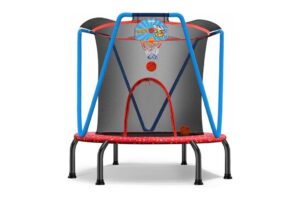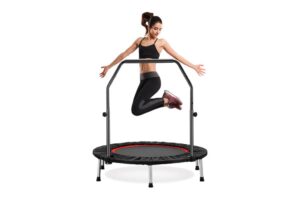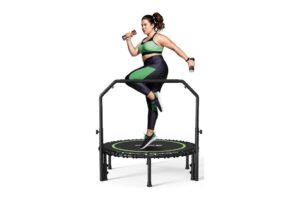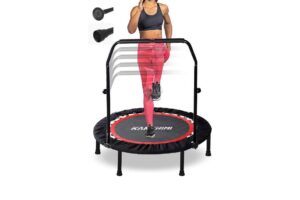Introduction
Are you prepared to elevate your fitness regimen? Our guide to trampoline rebounding for beginners offers an exhilarating way to boost your health and wellness while having a blast. Here, we’ll delve into the fundamentals of trampoline rebounding, exploring its essence, the myriad benefits it offers, and essential safety precautions to ensure your journey is as enjoyable as it is effective.
Understanding Trampoline Rebounding
Trampoline rebounding, also known as rebound exercise, involves performing various movements and exercises on a mini trampoline or rebounder. The surface of the trampoline provides a responsive platform that absorbs impact, making it easier on your joints while offering an effective cardiovascular workout.
At its core, trampoline rebounding engages your entire body, activating muscles from head to toe. Whether you’re bouncing lightly or performing dynamic movements, the trampoline’s elasticity challenges your balance, coordination, and stability, resulting in a full-body workout with minimal strain.
Benefits of Trampoline Rebounding for Beginners
The benefits of trampoline rebounding for beginners are vast and diverse, making it an appealing choice for individuals of all fitness levels. Here’s a glimpse into some of the remarkable advantages:
- Cardiovascular Health: Bouncing on a trampoline gets your heart pumping, improving cardiovascular health and endurance.
- Low-Impact Exercise: Unlike running or jumping on hard surfaces, trampoline rebounding is gentle on the joints, reducing the risk of injury.
- Muscle Tone and Strength: The continuous bouncing motion engages various muscle groups, leading to improved muscle tone and strength.
- Lymphatic Drainage: Rebounding facilitates lymphatic circulation, aiding in detoxification and boosting the immune system.
- Stress Reduction: The rhythmic bouncing rhythm of trampoline rebounding can be therapeutic, helping to alleviate stress and promote relaxation.
Safety Precautions
While trampoline rebounding is a fun and effective form of exercise, it’s essential to prioritize safety to prevent injuries. Consider these essential safety measures:
- Appropriate Footwear: ensure you wear supportive athletic footwear with reliable traction to minimize the risk of slipping.
- Warm-Up: Always start with a gentle warm-up to prepare your body for exercise and prevent muscle strain.
- Controlled Movements: Begin with simple bouncing motions and gradually progress to more advanced exercises as your skills improve.
- Stay Centered: Maintain proper posture and balance by staying centered on the trampoline surface.
- Clear Surroundings: Ensure that the area around the trampoline is free from obstacles to avoid collisions or falls.
By understanding the essence of trampoline rebounding, embracing its myriad benefits, and adhering to essential safety precautions, you can embark on your journey with confidence and enthusiasm. So, lace up your shoes, step onto the trampoline, and let the exhilarating world of rebounding for beginners unfold before you!
Choosing the Ideal Trampoline
Embarking on the journey of rebounding for beginners necessitates careful consideration when choosing the right trampoline. This guide to trampoline rebounding for beginners is tailored to assist newcomers in making informed decisions, focusing on crucial aspects such as size, quality, durability, and safety features, ensuring a seamless transition into the world of rebounding.
Size Considerations
Regarding trampoline rebounding for beginners, finding the size of the trampoline plays a pivotal role in ensuring an optimal experience. Adequate space for movement and comfortable bouncing is essential for safety and enjoyment. Home trampolines typically range from 8 to 15 feet in diameter, with larger sizes accommodating multiple users simultaneously.
Assess your available space and select a size that offers ample room without feeling constrained, facilitating uninhibited movement and enhancing the rebounding for beginners.
Quality and Durability
Investing in a high-quality trampoline is paramount for beginners, guaranteeing longevity and stability throughout their rebounding journey.
Look for trampolines constructed from durable materials such as galvanized steel frames and UV-resistant jumping mats, capable of withstanding outdoor elements and frequent use. Evaluate the trampoline’s construction and ensure secure attachment points for springs and frame components to minimize the risk of accidents or injuries.
Consider the weight capacity of the trampoline to accommodate users of all sizes and ages, ensuring durability and resilience to rigorous workouts over time.
Safety Features
Safety is of utmost importance when selecting a trampoline for rebounding for beginners, prioritizing features that mitigate potential risks during rebounding sessions. Opt for trampolines equipped with safety enclosures or nets to prevent beginners from falling off the trampoline surface. Ensure the enclosure is securely attached to the frame and features padded poles or edges to minimize the risk of impact injuries.
Additionally, look for trampolines with reinforced spring covers and frame padding to cushion landings and reduce the likelihood of pinching or trapping limbs during use. Consider accessories like ladder attachments or anchor kits to enhance stability and prevent tipping or movement during vigorous bouncing, fostering a safe environment for beginners to thrive in their rebounding pursuits.
Selecting the right trampoline involves thoughtful consideration of size, quality, durability, and safety features, ensuring a safe and rewarding rebounding experience.
By prioritizing these factors, beginners can embark on their rebounding journey with confidence, knowing they’ve chosen a trampoline that meets their needs and supports their fitness goals. With the right trampoline as their foundation, beginners can embrace the exhilarating world of rebounding, unlocking a myriad of health benefits and discovering the joy of bouncing their way to improved well-being
Essential Techniques for Beginners
Embarking on your rebounding journey as a beginner is an exciting endeavor filled with possibilities for improved fitness and well-being. Here, we’ll delve into fundamental techniques to help you get started on the right foot, focusing on proper warm-up, balance and stability exercises, and basic bouncing techniques to set the stage for a successful rebounding experience.
Proper Warm-up for Beginners
Before you take to the trampoline, it’s essential to prepare your body with a thorough warm-up routine. A thorough warm-up routine boosts blood circulation to your muscles, improves flexibility, and lowers the likelihood of injury.
Begin with light cardiovascular exercises such as brisk walking or jogging on the spot to elevate your heart rate. Follow this with dynamic stretches targeting major muscle groups, including leg swings, arm circles, and torso twists. Dedicate at least 5-10 minutes to warming up to ensure your body is primed for the rebounding session ahead.
Balance and Stability Exercises
Developing balance and stability is crucial for mastering rebounding techniques and maintaining control on the trampoline. Incorporate balance exercises into your routine to improve proprioception and coordination.
Start with simple exercises like single-leg stands, gradually progressing to more challenging variations such as balancing on a stability ball or wobble board. Additionally, include stability exercises like squats, lunges, and planks to strengthen your core and enhance overall stability. These exercises not only enhance your performance on the trampoline but also contribute to better posture and injury prevention in everyday life.
Basic Bouncing Techniques for Beginners
With your body warmed up and your balance honed, it’s time to explore basic bouncing techniques on the trampoline.
Begin with gentle, controlled bounces, focusing on landing softly with each jump. Keep your knees slightly bent and your core engaged to absorb the impact and maintain stability.
Gradually increase the height and intensity of your bounces as you become more comfortable on the trampoline. Experiment with different foot positions and arm movements to vary your bounce and engage different muscle groups. Remember to maintain proper posture and alignment throughout your rebounding session to maximize effectiveness and minimize the risk of injury.
By incorporating proper warm-up, balance and stability exercises, and basic bouncing techniques into your rebounding routine, you’ll establish a solid foundation for success as a beginner. Consistency and patience are key as you continue to practice and refine your skills on the trampoline. With dedication and perseverance, you’ll soon experience the exhilarating benefits of rebounding and unlock your full potential for health and fitness.
Progressing Skills in Rebounding for Beginners
As you continue your journey into rebounding as a beginner, it’s essential to progress your skills gradually to unlock new challenges and benefits. Here, we’ll explore techniques to elevate your practice, focusing on increasing height and intensity, adding variations like twists, turns, and jumps, and incorporating fitness elements to take your rebounding experience to the next level.
Increasing Height and Intensity
Once you’ve mastered the basics of bouncing on the trampoline, it’s time to elevate your practice by increasing height and intensity. Start by focusing on achieving higher jumps with each bounce, using the strength of your legs to propel yourself upward. As you become more comfortable, experiment with adding power to your jumps, aiming to reach greater heights while maintaining control and stability.
Gradually increase the intensity of your rebounding sessions by incorporating interval training, alternating between periods of high-intensity bouncing and active recovery to challenge your cardiovascular system and boost calorie burn.
Adding Variations: Twists, Turns, and Jumps
To keep your rebounding workouts fresh and engaging, incorporate a variety of variations, including twists, turns, and jumps. Start by practicing simple twists and turns while in mid-air, using your core muscles to rotate your body gently.
As you build confidence, experiment with more dynamic movements like 180-degree or 360-degree spins, challenging your coordination and balance. Introduce jumps and plyometric exercises to your routine, such as tuck jumps, split jumps, and scissor jumps, to enhance power, agility, and explosive strength.
These variations not only add excitement to your workouts but also target different muscle groups for a more comprehensive fitness experience.
Incorporating Fitness Elements
Take your rebounding workouts to the next level by incorporating fitness elements that target specific areas of your body and enhance overall conditioning. Integrate strength training exercises like squats, lunges, and push-ups into your rebounding routine, using the instability of the trampoline surface to engage more muscles and amplify the effectiveness of each movement. Incorporate resistance bands or hand weights to add resistance and challenge your muscles further.
Explore cardio-focused routines that combine rebounding with other forms of aerobic exercise, such as dance-inspired choreography or high-intensity interval training (HIIT), to maximize calorie burn and cardiovascular benefits.
By progressing your skills in rebounding through increasing height and intensity, adding variations, and incorporating fitness elements, you’ll continue to challenge your body and mind while reaping the numerous benefits of this dynamic and exhilarating form of exercise. With dedication and persistence, you’ll elevate your rebounding practice to new heights and achieve your fitness goals with confidence.
Advanced Tips for Rebounding for Beginners
As you progress on your rebounding journey as a beginner, you’ll inevitably reach a point where you’re ready to delve into more advanced techniques and strategies. Here, we’ll explore advanced tips and tricks tailored specifically for rebounding beginners, focusing on mastering complex moves, fine-tuning form and control, and preventing common injuries to ensure a safe and rewarding experience.
Mastering Complex Moves
Once you’ve established a solid foundation in rebounding, it’s time to challenge yourself with more complex moves and combinations. Experiment with advanced techniques such as double bounces, where you rebound twice in quick succession, or aerial maneuvers like front flips and back flips.
Practice these moves under controlled conditions, starting with low heights and gradually increasing the intensity as you gain confidence and proficiency. Remember to focus on proper technique and body positioning to execute each move safely and effectively.
Fine-tuning Form and Control
As you advance in your rebounding practice, honing your form and control becomes increasingly important for maximizing performance and minimizing the risk of injury. Pay attention to your posture, keeping your spine aligned and your core engaged throughout each movement. Focus on landing softly with bent knees to absorb impact and reduce strain on your joints.
Practice controlled movements and transitions between exercises, maintaining stability and balance at all times. Incorporate drills and exercises that target specific areas of weakness, such as balance or coordination, to improve overall control and precision in your rebounding practice.
Preventing Common Injuries
While rebounding is a low-impact exercise, injuries can still occur if proper precautions are not taken. To minimize the risk of injury, it’s essential to be mindful of your body’s limits and listen to any warning signs of discomfort or pain.
Avoid overexertion and take regular breaks to allow your body to recover between sessions. Invest in quality footwear with good support and traction to prevent slips and falls. Warm up thoroughly before each rebounding session to prepare your muscles and joints for exercise, and incorporate stretching and cool down exercises to aid in recovery and prevent muscle stiffness.
By mastering complex moves, fine-tuning form and control, and preventing common injuries, rebounding beginners can elevate their practice to new heights while staying safe and injury-free. Remember to approach advanced techniques with patience and caution, gradually progressing as you build strength, skill, and confidence. With dedication and perseverance, you’ll continue to unlock new levels of mastery and enjoyment in your rebounding journey.
Creating Your Routine
As you delve deeper into the world of rebounding for beginners, establishing a consistent and effective routine is key to maximizing your progress and achieving your fitness goals. Here, we’ll explore the essential elements of building a rebounding routine, including designing your workout, setting goals, tracking progress, and prioritizing rest and recovery for optimal results.
Designing Your Rebounding Workout
Designing a well-rounded rebounding workout involves selecting a variety of exercises and techniques that target different muscle groups and fitness components. Begin by incorporating basic bouncing movements, focusing on proper form and control to build strength and coordination. Gradually introduce variations such as twists, turns, and jumps to challenge your agility and balance.
Incorporate strength training exercises like squats, lunges, and push-ups to build muscle and improve overall conditioning. Experiment with interval training or circuit workouts to boost cardiovascular fitness and calorie burn. Be sure to include a thorough warm-up and cool down in each session to prepare your body for exercise and promote recovery.
Setting Goals and Tracking Progress
Setting specific, measurable goals is essential for staying motivated and monitoring your progress as a rebounding beginner. Start by identifying your objectives, whether it’s improving endurance, building strength, or losing weight. Break down your goals into smaller, achievable targets that you can track over time.
Keep a workout journal or use a fitness app to record your workouts, noting the duration, intensity, and any milestones achieved. Regularly reassess your goals and adjust your routine accordingly to keep challenging yourself and maintain momentum.
Incorporating Rest and Recovery
Rest and recovery are often overlooked but crucial components of any effective rebounding routine for beginners. Allow your body time to recover between workouts to prevent over-training and reduce the risk of injury. Aim for at least one or two rest days per week to give your muscles and joints a chance to repair and rebuild.
Incorporate active recovery activities such as walking, swimming, or yoga on rest days to promote blood flow and flexibility. Listen to your body and prioritize sleep, hydration, and nutritious eating to support optimal recovery and overall well-being.
By designing a balanced rebounding workout, setting goals, tracking progress, and prioritizing rest and recovery, beginners can establish a solid foundation for long-term success and enjoyment in their rebounding journey. Ensure to maintain patience and consistency, and acknowledge and celebrate every achievement as you progress. With dedication and perseverance, you’ll continue to progress and achieve your fitness aspirations with rebounding as your guide.
Special Considerations in Rebounding for Beginners
As you delve deeper into the world of rebounding for beginners, it’s essential to explore special considerations that cater to specific needs and goals. Beyond the basics lies a realm of possibilities where rebounding becomes not just a workout, but a transformative experience for weight loss, rehabilitation, injury prevention, stress relief, and mental well-being.
Rebounding for Weight Loss and Fitness
For beginners seeking to shed excess weight and enhance their fitness levels, rebounding offers a dynamic and effective solution. The repetitive bouncing motion engages major muscle groups, elevating heart rate and calorie burn for a potent cardiovascular workout.
Furthermore, the instability of the trampoline surface challenges core stability and strengthens muscles throughout the body. By incorporating rebounding into your fitness routine regularly, beginners can accelerate weight loss, boost metabolism, and improve overall fitness levels in a fun and low-impact manner.
Rebounding for Rehabilitation and Injury Prevention
Rebounding holds tremendous potential for beginners recovering from injuries or aiming to prevent future ones. The gentle, low-impact nature of rebounding minimizes stress on joints and ligaments, making it ideal for individuals with joint pain or mobility limitations.
The rhythmic bouncing motion stimulates circulation and promotes healing, making it beneficial for rehabilitation from injuries such as sprains, strains, or fractures. Additionally, the proprioceptive feedback provided by the trampoline surface enhances balance and coordination, reducing the risk of falls and enhancing overall stability.
Rebounding for Stress Relief and Mental Well-being
In addition to its physical benefits, rebounding offers profound effects on mental well-being and stress relief for beginners. The rhythmic bouncing motion induces a state of relaxation and mindfulness, helping to alleviate stress and anxiety.
The release of endorphins during rebounding promotes feelings of happiness and relaxation, providing a natural mood boost and combating symptoms of depression. By incorporating rebounding into your daily routine, beginners can experience a significant reduction in stress levels, improved mental clarity, and enhanced overall well-being.
In conclusion, as beginners explore the special considerations of rebounding for weight loss and fitness, rehabilitation and injury prevention, and stress relief and mental well-being, they unlock a world of possibilities for transformative health and wellness.
Whether you’re aiming to shed pounds, recover from injury, or find solace from life’s stresses, rebounding offers a holistic approach to health and well-being that can be tailored to your individual needs and goals. So embrace the journey, dear beginner, and discover the myriad benefits that rebounding has to offer on your path to a healthier, happier you.
FAQs and Troubleshooting
As you embark on your journey into rebounding for beginners, you may encounter questions, challenges, and uncertainties along the way. Here, we’ll tackle common queries, address potential challenges and plateaus, and discuss the importance of seeking professional guidance to ensure a smooth and successful rebounding experience.
Answering Common Questions
What equipment do I need to start rebounding?
All you need is a quality mini trampoline or rebounder and supportive athletic shoes.
How often should I rebound as a beginner?
Aim for at least 3-4 sessions per week to build consistency and see progress.
How long should my rebounding sessions be?
Start with 15-20 minutes and gradually increase the duration as your fitness level improves.
Addressing Challenges and Plateaus
- Feeling sore after rebounding: It’s normal to experience muscle soreness, especially as a beginner. Make sure to warm up properly before each session and gradually increase intensity to prevent excessive soreness.
- Struggling with balance: Balance takes time to develop. Practice simple balance exercises on and off the trampoline to improve stability and coordination.
- Not seeing progress: Plateaus are common in any fitness journey. Mix up your routine, challenge yourself with new exercises, and set realistic goals to keep motivation high.
Seeking Professional Guidance
- Consulting with a fitness trainer: A certified fitness trainer can provide personalized guidance, help you set realistic goals, and design a tailored rebounding program to meet your needs.
- Physical therapist or chiropractor: If you have pre-existing injuries or medical conditions, seeking guidance from a healthcare professional can ensure safe and effective participation in rebounding.
- Joining a rebounding class: Participating in a rebounding class led by an experienced instructor can offer motivation, accountability, and proper technique instruction for beginners.
By addressing common questions, tackling challenges and plateaus, and seeking professional guidance when needed, beginners can navigate their rebounding journey with confidence and success. Remember, patience and persistence are key as you embark on this exciting path to improved health and fitness with rebounding as your guide.
Conclusion
As we come to the end of our guide on rebounding for beginners, it’s time to reflect on the exhilarating journey you’ve embarked upon and look ahead to the exciting possibilities that await. Here, we’ll celebrate the joy of trampoline rebounding and empower you to continue your journey with confidence and enthusiasm.
The Joy of Rebounding for Beginners
Trampoline rebounding for beginners isn’t just about fitness—it’s a journey filled with excitement, exhilaration, and pure joy. As you step onto the trampoline surface, you’re greeted with a sense of freedom and lightness that transcends the mundane.
Each bounce becomes a celebration of movement, a dance with gravity that invigorates your body and uplifts your spirit. From the moment you take that first leap, you’re embraced by the infectious energy of rebounding, propelled forward by the sheer thrill of the experience.
Discovering the Freedom of Movement
Trampoline rebounding offers beginners a unique opportunity to break free from the constraints of traditional exercise. With every bounce, you’re liberated from the monotony of repetitive workouts, transported to a world where movement is fluid, dynamic, and endlessly exhilarating.
Whether you’re soaring through the air with graceful leaps or simply bouncing to the rhythm of your own heartbeat, each moment on the trampoline is infused with a sense of joy and liberation that’s hard to find elsewhere.
Nourishing Body, Mind, and Soul
Beyond its physical benefits, rebounding nourishes your entire being—body, mind, and soul. The rhythmic motion of bouncing stimulates circulation, boosts energy levels, and promotes a sense of well-being that lasts long after your workout is over.
As you surrender to the rhythm of the bounce, you find yourself immersed in a state of mindfulness and presence, free from the worries and stresses of daily life. In this moment of pure bliss, you discover a newfound connection to yourself and the world around you—a connection that fuels your passion for rebounding and ignites your desire to continue this journey with unwavering enthusiasm.
Celebrating Every Moment
As a beginner, every moment on the trampoline is a cause for celebration—a testament to your courage, determination, and willingness to embrace new experiences. Whether you’re conquering new skills, pushing past your limits, or simply reveling in the sheer joy of movement, know that each bounce brings you one step closer to realizing your full potential.
So savor every moment, cherish every leap, and embrace the thrill of rebounding with all your heart. For in this exhilarating journey, the joy of rebounding is not just found in reaching your destination—it’s found in every step you take along the way.
Continuing Your Rebounding Journey
As you progress on your rebounding journey as a beginner, confidence becomes your steadfast companion, guiding you through each bounce and leap with assurance and poise. In this segment, we delve into how to continue your journey with confidence, empowering you to embrace new challenges, conquer fears, and soar to greater heights in your rebounding practice.
Embrace Your Progress
One of the keys to building confidence in rebounding for beginners is acknowledging and celebrating your progress. Take a moment to reflect on how far you’ve come since you first stepped onto the trampoline.
Celebrate the milestones you’ve achieved, whether it’s mastering a new technique, increasing your endurance, or simply feeling more comfortable and confident on the trampoline. By recognizing your achievements, you cultivate a positive mindset that fuels your motivation and reinforces your belief in your abilities.
Set Realistic Goals
Setting goals is another essential component of building confidence in rebounding for beginners. Take the time to define clear, achievable objectives that align with your aspirations and abilities. Whether it’s improving your bounce height, mastering a specific move, or committing to a regular workout schedule, setting goals provides you with direction and purpose in your rebounding practice.
By setting realistic goals, you create a road map for success that bolsters your confidence and keeps you focused on your journey.
Challenge Yourself
Confidence flourishes when you step outside your comfort zone and embrace new challenges. As a beginner in rebounding, don’t be afraid to push yourself beyond familiar boundaries and try new things. Experiment with different techniques, variations, and workout routines to keep your practice fresh and engaging.
Challenge yourself to go a little higher, bounce a little faster, or try a more advanced move. While stepping out of your comfort zone may feel daunting at first, it’s through facing challenges that you discover your true potential and build unshakable confidence in your abilities.
Seek Support and Encouragement
Finally, remember that you’re not alone on your rebounding journey. Seek support and encouragement from fellow beginners, experienced rebounders, or online communities dedicated to rebounding. Surround yourself with positive influences that uplift and inspire you, providing a sense of camaraderie and solidarity as you navigate the ups and downs of your journey.
Share your successes, seek advice when needed, and offer encouragement to others on their own paths. By fostering a supportive network, you cultivate a sense of belonging and confidence that propels you forward with renewed vigor and determination.
In Conclusion, as you continue your rebounding for beginners journey, remember that confidence is not a destination but a journey—a journey filled with challenges, triumphs, and endless possibilities.
Embrace your progress, set realistic goals, challenge yourself, and seek support from those around you. With each bounce, you’re not just strengthening your body—you’re cultivating confidence, resilience, and self-belief that will serve you well both on and off the trampoline. So continue your journey with confidence, dear beginner, knowing that the path ahead is yours to explore and conquer!
Related posts:
- Rebounding for Cardio Fitness: Unlock Heart Health Power
- Trampoline Bounce Revolution: Energize Your Jumps with Explosive Power
- Trampoline Exercises: Energize Your Workout with Dynamic Bouncing
- Trampoline Ground Preparation: Mastering the Art of Bouncing Success
- Trampoline Maintenance Essentials: Energize Your Jumping Fun








